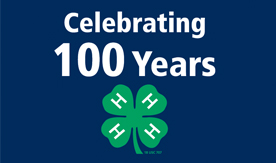
UMaine Extension’s 4-H Program Marks 100 Years in Maine
Maine 4-H, which turns 100 years old this year, has a lot to celebrate — deep roots, a large, supportive family and a lot of successes.
Today, 4-H youth programs enrich children’s lives through technology and hands-on programming. 4-H — which stands for head, hands, heart and health — is the youth development branch of University of Maine Cooperative Extension. Extension leaders and volunteers utilize university resources to develop the life skills and broaden horizons of 30,000 Maine children each year.
If youth ages 5–18 are interested in raising steers, making cheese, shearing goats, learning about tractor safety, sewing, growing vegetables and being a member of a Dairy Quiz Bowl Team, UMaine Extension has opportunities for them.
And if they’re fascinated with rocketry, adventure camps, new media photography, Junior Maine Guiding, public speaking, climate change, website development and LEGO robotics, 4-H has programs for them as well.
While 4-H has grown in size and scope since its inception in Maine in 1913, its core belief is the same — children are the promise for the future.
As 4-H history goes, in the late 1800s and early 1900s, farmers were reluctant to use new agricultural techniques developed by public university researchers, so universities established rural youth programs to introduce the concepts to children, which they eagerly shared with their parents.
Alumni praise 4-H for the positive and lasting impact it’s had in their lives.
Maine Assistant Attorney General Patrick Larson, a 1985 UMaine graduate, enjoyed hunter safety, outdoor programming, photography, cooking and electricity demonstrations as a member of Union River Valley 4-H in Aurora, Maine.
“The strong sense of public service and volunteerism I learned through 4-H helped me give back to the community later in life,” he says. “You learned that that was what you do; you offer your time to help others.”
Jodi Harnden of Wilton, Maine, says community service was also a vital component of the Dandy Crafter 4-H Club. Harnden, a third-year secondary education and mathematics double major at UMaine, says her group gave homemade quilts and crafts to residents and hospital patients, and raffled other crafts to support community service projects, including buying animal oxygen masks for area fire departments.
She says participating in 4-H trips and activities helped her develop skills and confidence. The peer tutor and snare drummer in the UMaine pep band wants to be a high school teacher.
Lisa Phelps, UMaine Extension’s 4-H program administrator, says the key is to empower children and raise aspirations. “I have had parents tell me that because of their child’s involvement in 4-H, he or she will graduate from high school and go on to college,” Phelps says. “And if they were not in 4-H, they would have most likely dropped out of school.”
John Rebar, executive director of UMaine Extension, says the self-directed, hands-on 4-H programs encourage children to learn about the world and all that they can achieve in it. “4-H provides the kinds of experiences that build skills and excitement that are remembered for a lifetime,” he says.
The glowing testimonials are backed by research. In 2008, initial results of Tufts University professor Richard Lerner’s longitudinal study indicated fifth-grade 4-H members across the country earned better grades, were more engaged in school and were more likely to envision themselves attending college than nonmembers.
That research supports UMaine Extension’s most recent efforts to increase UMaine recruitment, enrollment and retention through 4-H Science. The new statewide initiative was awarded a three-year Presidential Request for Visions of University Excellence (PRE-VUE) Program grant last summer as part of the university’s five-year strategic plan, the Blue Sky Project.
Contact: Jennifer O’Leary, 207.299.7751
